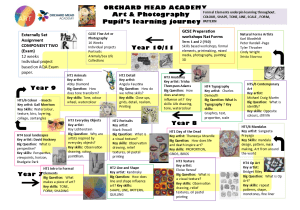Art is studied by all pupils at Orchard Mead Academy, with one hour lessons a week during Key Stage 3.
Art is an option for GCSE during Years 10 and 11.
Key Stage 4 Options
Students can opt to take AQA GCSE Fine Art or AQA GCSE Photography at Key Stage 4.
Both GCSEs promote learning across a variety of experiences and through using various tools, techniques, materials and resources to generate different kinds of evidence of working and outcomes.
You can find the full subject specifications here: https://www.aqa.org.uk/subjects/art-and-design/gcse/art-and-design-8201-8206/subject-content
AQA GCSE Fine Art
| Overview – What You Will Study: |
- The Fine Art GCSE is made up of 2 components. Unit 1 – the Portfolio, which is worth 60% of your total grade and Unit 2 – the Externally Set Assignment, which makes up the final 40% of your grade.
Unit 1
- Unit one is made of 3 projects which include Natural Forms and Close Ups.
- For each project you will create a sketchbook which includes observational drawing, your own photography, artist research and experimentation with a range of materials and techniques.
- At the end of project, you produce a final piece. In Year 11 your final piece will be created in a 5 hour practical MOCK exam.
Unit 2
- Unit 2 is a project brief set by the exam board in January of Year 11. You have a set amount of lessons to produce a sketchbook of ideas exploring the theme. You must link your work to chosen artists and prepare for your final examination.
- You will produce a final outcome in your 10 hour art exam at the end of this unit.
- In GCSE Fine art you will achieve a grade from 1–9.
AQA GCSE Photography
| Overview – What You Will Study: |
- The Photography GCSE is made up of 2 components. Unit 1 – the Portfolio, which is worth 60% of your total grade and Unit 2 – the Externally Set Assignment, which makes up the final 40% of your grade.
Unit 1
- Unit one is made of 3 projects which include Natural Forms and Close Ups.
- For each project you will create a photography portfolio which includes your own photography, edits, research and experimentation with a range of photo collage techniques.
- At the end of project, you produce a final photography piece. In Year 11 your final piece will be created in a 5 hour practical MOCK exam.
Unit 2
- Unit 2 is a project brief set by the exam board in January of Year 11. You have a set amount of lessons to produce a Presentation of ideas exploring the theme. You must link your work to chosen photographers and prepare for your final examination.
- You produce a final outcome in your 10 hour art exam at the end of this unit.
- In GCSE Photography you will achieve a grade from 1–9.
For information about enrichment clubs and revision clubs please visit our clubs page here.
Websites
AQA GCSE Art, Craft and Design (8201)
https://www.bbc.com/bitesize/subjects
https://www.studentartguide.com/
Subject Leader/s
Mrs K. James


